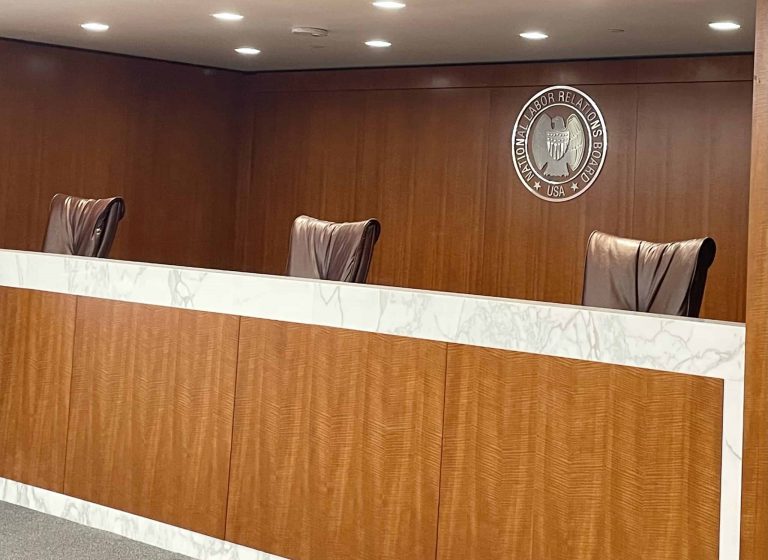
Andrew Strom is a union lawyer based in New York City. He is also an adjunct professor at Brooklyn Law School.
What should the remedy be when your employer threatens to kill your co-worker who started the union organizing drive? Yes, this really happened a few years back, and the NLRB ordered the employer to “cease and desist from threatening to kill its employees because they support the Union,” and it further ordered the employer to post a notice assuring the workers that it would not threaten to kill them.
Fortunately, it is shockingly rare for an employer to threaten to kill its workers for trying to unionize, but Kate Bronfenbrenner has found that it is quite common for employers to threaten workers in other ways, such as threatening to close a facility if the workers unionize. These kinds of threats can be quite effective in defeating a union organizing drive, yet under current Board law, the only remedy is a prospective cease and desist order along with a notice posting. As a result, employers get one free chance to take their best shot at intimidating workers before facing any consequences.
While courts have sometimes struck down the NLRB’s chosen remedy as punitive, a recent D.C. Circuit opinion serves as a reminder that the Board has broad discretion to order employers “to take such affirmative action … as will effectuate the policies of the [NLRA].” In Camelot Terrace Inc. v. NLRB, the court upheld a Board order requiring an employer to reimburse a union’s bargaining expenses where the NLRB finds that the employer has engaged in egregious bad-faith bargaining. The court reasoned that “a more traditional remedy, such as a bargaining order, is of little value if one party can drain another of its resources by bargaining in bad faith and then extracting concessions as the money wanes.” The court further noted that “limiting the remedy to the conventional bargaining order would effectively permit the employer to benefit from its violations of the Act.”
The Board should build on the logic of the Camelot Terrace decision to formulate a more meaningful remedy where an employer egregiously interferes with its workers’ union organizing efforts. If an employer succeeds in stopping, or even delaying, a union organizing drive through its illegal acts, the workers are entitled to compensation for the interference with their rights. But the challenge is how to measure the harm to the workers. One very conservative measure would be to look at the total amount of money the employer has spent on its anti-union campaign. The NLRA is premised on the theory that by organizing, workers increase their bargaining power and they are able to redirect some of the employer’s profits toward higher wages and benefits (or more leisure time). Presumably, when a rational employer decides to spend money fighting unionization, the employer has determined that the amount spent fighting the union drive would be less than the amount of profits that a successful drive would redirect into workers’ pockets. Of course, since an employer will only spend as much money as necessary to defeat the organizing drive, the dollars spent on an anti-union campaign are likely to far understate the expected gains to workers. While this is a very rough measure of the harm to workers, courts have long recognized that damages should be awarded even when the extent of the damages is uncertain, and that it is appropriate to resolve any uncertainty against the wrongdoer.
I’m not aware of any other legal regime where a perpetrator is allowed one free strike. It’s time for the NLRB to impose a remedy for unlawful threats that acknowledges how harmful they can be, and that at least attempts to compensate the victims.






Daily News & Commentary
Start your day with our roundup of the latest labor developments. See all
December 22
Worker-friendly legislation enacted in New York; UW Professor wins free speech case; Trucking company ordered to pay $23 million to Teamsters.
December 21
Argentine unions march against labor law reform; WNBA players vote to authorize a strike; and the NLRB prepares to clear its backlog.
December 19
Labor law professors file an amici curiae and the NLRB regains quorum.
December 18
New Jersey adopts disparate impact rules; Teamsters oppose railroad merger; court pauses more shutdown layoffs.
December 17
The TSA suspends a labor union representing 47,000 officers for a second time; the Trump administration seeks to recruit over 1,000 artificial intelligence experts to the federal workforce; and the New York Times reports on the tumultuous changes that U.S. labor relations has seen over the past year.
December 16
Second Circuit affirms dismissal of former collegiate athletes’ antitrust suit; UPS will invest $120 million in truck-unloading robots; Sharon Block argues there are reasons for optimism about labor’s future.